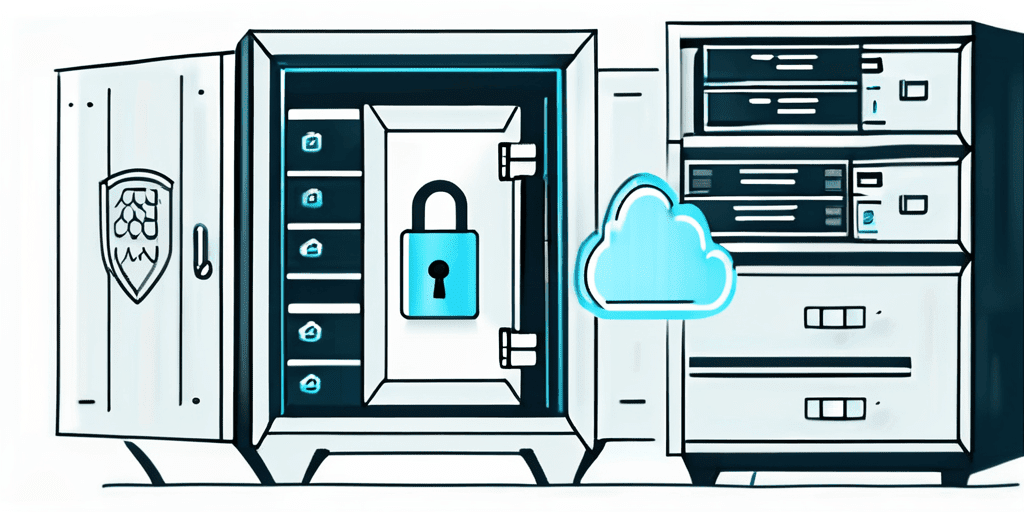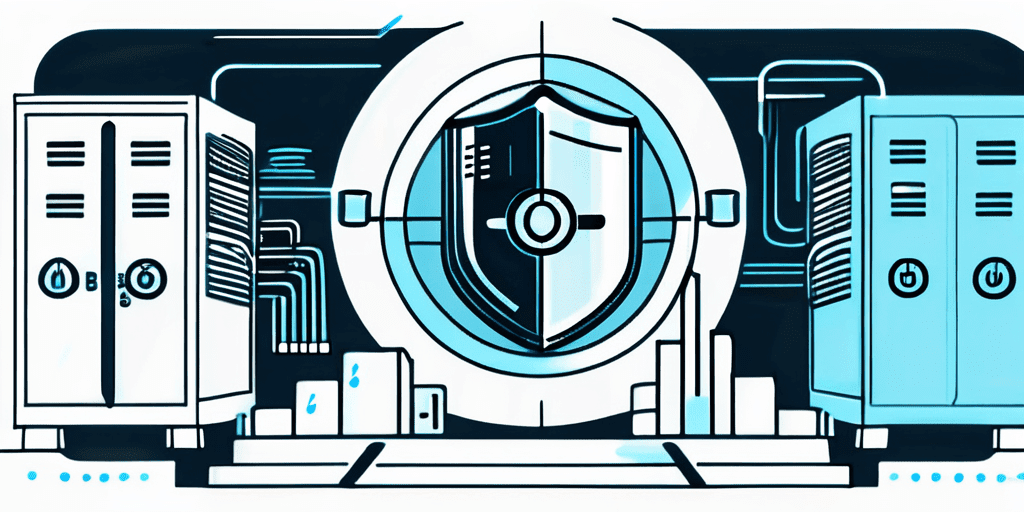In today’s digital world, the importance of protecting sensitive data cannot be overstated. With the increasing number of cyberattacks and data breaches, organizations must take proactive measures to secure their data. Encrypting data at rest is one such measure that is vital in ensuring data security. This article will explore the best practices for encrypting data at rest and the key concepts, steps, and maintenance strategies involved in this process.
Understanding the Importance of Data Encryption
Data encryption is the process of converting plain text into ciphertext, making it unreadable to unauthorized individuals. When data is encrypted at rest, it remains protected even if it falls into the wrong hands. Encryption provides an extra layer of security, ensuring that sensitive information, such as customer data, financial records, and intellectual property, remains confidential and cannot be accessed or modified without proper authorization.

The Role of Data Encryption in Security
Data encryption plays a crucial role in maintaining data security. By encrypting data at rest, organizations can prevent unauthorized access to sensitive information stored on various devices, including servers, databases, and storage systems. Without encryption, even if a malicious actor gains access to these devices, they will not be able to decipher the encrypted data, rendering it useless.
Risks of Not Encrypting Data at Rest
The risks of not encrypting data at rest are significant. Data breaches can result in financial loss, damage to the organization’s reputation, and legal repercussions. In recent years, many high-profile data breaches have highlighted the importance of data encryption. For example, in 2017, Equifax, one of the largest credit reporting agencies, experienced a massive data breach that exposed the personal information of approximately 147 million individuals. The lack of encryption contributed to the severity of the breach and the subsequent consequences.
Furthermore, data encryption not only protects against external threats but also safeguards against internal vulnerabilities. Insider threats, such as disgruntled employees or contractors with access to sensitive data, pose a significant risk to organizations. Encrypting data at rest ensures that even if an insider gains unauthorized access, they will not be able to read or misuse the encrypted information.
Moreover, data encryption is essential for compliance with various industry regulations and data protection laws. Many sectors, including healthcare, finance, and government, have specific requirements for protecting sensitive data. Encryption helps organizations meet these compliance standards and avoid penalties or legal consequences.
Key Concepts in Data Encryption
Before delving into the steps involved in encrypting data at rest, it is essential to understand some key concepts related to encryption.
Encryption is a fundamental process used to protect sensitive information from unauthorized access. By converting data into an unreadable format, encryption ensures that even if an attacker gains access to the data, they would not be able to decipher its contents without the proper decryption key.
Defining Data at Rest
Data at rest refers to the information that is stored on physical or digital media, such as hard drives, backup tapes, or cloud storage. This data remains dormant and is not actively being processed or transmitted. Encrypting data at rest ensures its protection even when it is not in use.
Imagine a scenario where a laptop containing sensitive customer data is stolen. Without proper encryption, the thief would have easy access to all the information stored on the device. However, if the data is encrypted, it becomes virtually useless to the thief, as they would need the decryption key to make any sense of the encrypted data.
Overview of Encryption Algorithms
Encryption algorithms are mathematical formulas that determine how data is converted from plaintext to ciphertext and vice versa. Numerous encryption algorithms are available, each with its strengths and weaknesses. Examples of commonly used encryption algorithms include Advanced Encryption Standard (AES), Rivest Cipher (RC4), and Data Encryption Standard (DES).
These encryption algorithms employ complex mathematical operations to ensure the confidentiality and integrity of the data. The choice of encryption algorithm depends on various factors, such as the level of security required, the computational resources available, and the specific use case. For instance, AES is widely regarded as one of the most secure encryption algorithms and is commonly used to protect sensitive information.
Public Key vs Private Key Encryption
In encryption, there are two primary types of encryption keys: public keys and private keys. Public key encryption, also known as asymmetric encryption, uses a pair of keys: a public key and a private key. The public key is used to encrypt data, while the private key is used for decryption. This type of encryption is particularly useful for secure communication over untrusted networks, as the public key can be freely shared without compromising the security of the data.
On the other hand, private key encryption, also known as symmetric encryption, uses a single key for both encryption and decryption. This type of encryption is faster and more efficient than public key encryption but requires a secure method of sharing the encryption key between the sender and the recipient. Symmetric encryption is commonly used for encrypting large volumes of data, such as databases or files stored on a local disk.
Understanding the differences between public key and private key encryption is crucial in designing secure encryption systems. By utilizing the appropriate encryption algorithms and key management practices, organizations can ensure the confidentiality and integrity of their data, both at rest and in transit.
Steps to Encrypt Data at Rest
Implementing data encryption at rest involves several crucial steps to ensure the security of sensitive information.

Identifying Sensitive Data
The first step in encrypting data at rest is to identify the sensitive data that requires protection. This includes personally identifiable information (PII), financial data, intellectual property, and any other data that, if compromised, could harm individuals or the organization.
Identifying sensitive data is a complex process that requires a comprehensive understanding of the organization’s data landscape. It involves conducting thorough data classification exercises, collaborating with key stakeholders, and leveraging advanced data discovery tools. By meticulously identifying sensitive data, organizations can prioritize their encryption efforts and allocate resources effectively.
Choosing the Right Encryption Tools
Once the sensitive data is identified, organizations need to select appropriate encryption tools. The choice of encryption tools depends on various factors, such as the type of data, storage systems used, and compliance requirements. It is crucial to select encryption solutions from reputable vendors and ensure they align with industry best practices.
When selecting encryption tools, organizations should consider the scalability, performance, and compatibility of the solutions. Additionally, evaluating the encryption algorithms and key management capabilities of the tools is essential to ensure robust protection of data at rest. By carefully evaluating and choosing the right encryption tools, organizations can establish a strong foundation for data security.
Implementing Encryption Protocols
After selecting the encryption tools, organizations need to implement encryption protocols across all applicable systems and devices. This includes servers, databases, laptops, and mobile devices. The encryption protocols should be designed to secure data at rest by encrypting the stored data and managing the encryption keys effectively.
Implementing encryption protocols requires meticulous planning and coordination across various teams within the organization. It involves defining encryption policies, configuring encryption settings, and establishing robust key management practices. Organizations should also consider integrating encryption protocols with existing security controls, such as access controls and intrusion detection systems, to provide a layered defense against potential threats.
Furthermore, organizations should regularly review and update their encryption protocols to adapt to evolving security threats and technological advancements. By continuously enhancing encryption protocols, organizations can stay ahead of potential vulnerabilities and ensure the long-term security of their data at rest.
Maintaining and Updating Encryption Practices
Encrypting data at rest is not a one-time activity; it requires regular maintenance and updates to ensure the effectiveness of the encryption measures.

Regular Audits of Encryption Strength
Organizations should conduct regular audits to assess the strength of their encryption practices. These audits can involve penetration testing, vulnerability assessments, and compliance audits to identify any weaknesses or vulnerabilities in the encryption setup.
During a penetration test, ethical hackers simulate real-world attacks to identify potential vulnerabilities in the encryption system. They employ various techniques, such as brute force attacks, to test the strength of the encryption algorithms and keys. By uncovering any weaknesses, organizations can take proactive measures to strengthen their encryption practices and protect their data.
Updating Encryption Keys
Encryption keys are an integral part of data encryption at rest. Over time, encryption keys may become outdated, weak, or compromised. Therefore, it is vital to update encryption keys periodically to maintain the confidentiality and integrity of the encrypted data.
When updating encryption keys, organizations should follow industry best practices, such as using strong cryptographic algorithms and generating random keys. Additionally, key rotation should be performed regularly to minimize the risk of key compromise. By implementing these measures, organizations can ensure that their encryption keys remain robust and effective in safeguarding sensitive information.
Staying Informed about New Encryption Technologies
The field of data encryption is continuously evolving, with new encryption technologies emerging regularly. Organizations should stay informed about the latest advancements in encryption techniques and assess their suitability for their data protection needs.
One such emerging technology is quantum encryption, which leverages the principles of quantum mechanics to provide unparalleled security. Quantum encryption uses quantum key distribution (QKD) to establish secure communication channels, making it resistant to attacks from quantum computers. By staying informed about such advancements, organizations can explore innovative encryption solutions that offer enhanced protection against evolving threats.
Furthermore, organizations should actively participate in industry conferences, webinars, and forums to stay updated on the latest encryption trends and practices. By networking with experts and peers, organizations can gain valuable insights and learn from real-world experiences, enabling them to make informed decisions regarding their encryption strategies.
In conclusion, encrypting data at rest is a critical best practice that organizations must adopt to safeguard sensitive information. By understanding the importance of data encryption, mastering key encryption concepts, following the necessary steps, and maintaining encryption practices, organizations can strengthen their data security posture and mitigate the risks associated with data breaches. Implementing robust data encryption measures is an investment that pays off in the form of regulatory compliance, customer trust, and peace of mind.
As you consider the vital steps to protect your organization’s data at rest, remember that the right partner can make all the difference. Blue Goat Cyber, a Veteran-Owned business, specializes in comprehensive B2B cybersecurity services tailored to your needs. From medical device cybersecurity to HIPAA and FDA compliance, and from SOC 2 to PCI penetration testing, our expertise is your asset in fortifying your defenses against cyber threats. Don’t leave your data security to chance. Contact us today for cybersecurity help and partner with a team that’s as committed to your protection as you are.
